Here we are in May. Actually, almost in the middle of the month, but never mind.
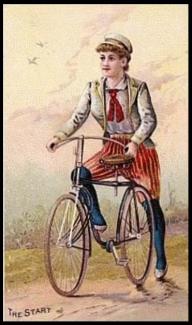
This week, for the first time, I started to learn a new skill, riding a pedal bicycle. I always wanted to learn, and never had the opportunity. I saw the classes advertised in a local carers magazine, and signed up straight away. There are between six and ten of us, and two days this week we bravely went from riding a hobby horse, striding along with our feet on the ground, to rolling down a slope with our feet (very slightly) off the ground, and then to actually pedalling. Next time we learn about gears. I cannot wait. If you get the chance to learn anything, do go. It is amazing fun, and any skill that tests your brain helps it stay active for longer. And whilst I may not ever look as glamorous as this lady, I do like the way that this card says "The Start".... perhaps of something good.
And if you want to read more about this card, it is featured as the diary date for Sunday, the 15th October, 2023 as part of our newsletter for the 14th of October, 2023
Now to our cards for this week, which begin with :
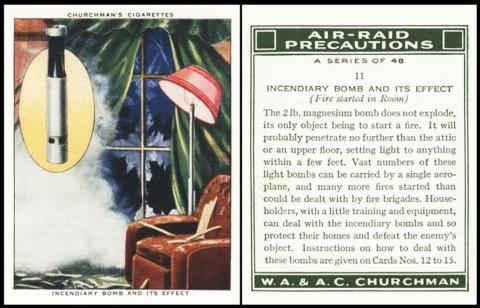
W.A. & A.C. Churchman [tobacco : UK] "Air Raid Precautions" - overseas issue (August 1938) 11/48 : C504-405 : C82-93 : C/5 (RB.10/5) Ha.544 : H.544
Today in 1941 the Palace of Westminster was badly damaged in an Air Raid, after a rain of incendiary and high-explosive bombs was dropped.
The main culprit in the damage was these incendiaries, which consisted of a tube shaped body of magnesium alloy, packed with thermite, a curious combination of an oxide of one, more stable metal, combined with a more easily combustible substance. This tube ended with a tail, which was riveted on and was designed to aid its direction after the bomb was released into the air.
We call them bombs, but they were technically not, as they did not explode. Instead they touched down, and a quite complex chain of events started to take place, firstly the impact of landing drove a thin spike into a percussion cap, and that ignited the thermite filling. That would blaze away, getting ever hotter, and it quickly melted the alloy casing, at which point the fire was released on to its surroundings. The "best" result was if it hit carpets, curtains, or soft furnishings and upholstery, which definitely proves that it was at least partially designed as a weapon against civilians, and homes.
This is what happened on that night, and in this blaze the House of Commons Chamber was totally destroyed, with the fire being so fierce that it spread to the Member`s Lobby, pulling down the ceilings as it went, whilst the House of Lords Chamber, Westminster Hall and even the Clock Tower were damaged.
The bombs were relatively small, and light, and you could fit a lot of them into an aeroplane. And though we speak of the German version attempting to destroy the Houses of Parliament, the British used them too, with devastating effect on cities such as Dresden.
Now we have an ever-growing blog on this set, all its variations, and the several other issuers, so here we will only discuss this one.
It first appears in our original 1948 Churchman reference book, RB.10, which lists two sets, the home issue of November 1938 and our issue, which, strangely, was earlier than the home issue. It does not really work unless I list both sets, so here they are:
- 4. November 1938. 48 AIR RAID PRECAUTIONS (titled series). Size 2 7/10” x 2 1/10” or 68 x 53 m/m. Numbered 1-48. Fronts printed by letterpress 4-colour halftone process. Backs printed in dark green, with descriptions, album clause and I.T.C. clause. Printed by Mardon, Son and Hall.
- see https://csgb.co.uk/publications/newsletter/2023-02-25
- 5. August 1938. AIR RAID PRECAUTIONS. Identical to (4) but omitting album and I.T.C. clauses. Overseas issue.
The World Tobacco Issues Index splits these up, moving the export issue to section three of the Churchman listings, which cover "Export issues without I.T.C. Clause. Issued 1937-39 through B.A.T. in Channel Islands, Malta, and British Garrisons overseas. All series are similar to the corresponding Home Issue under Section 2.B." . The entry reads;
- AIR RAID PRECAUTIONS. Md. Nd. (48). See Ha.544 – C82-93
And it remains the same in our updated World Tobacco Issues Index, just with a new code, of C504-730. The "H" code diverts you to the handbooks, where all the issuers are detailed. And you can see that, plus lots more information, at our blog page called A for Air Raid Precautions
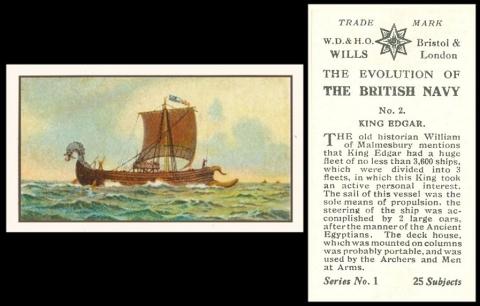
W.D. & H.O. Wills [tobacco : UK - Bristol] "The Evolution of the British Navy" (1910-15) 2/25 - W675-578 : W62-411 : W/197 [RB.16/197]
This one is an odd one, for it is recorded that today in 973 saw the first Coronation of King Edgar the Peaceful, and his wife/Queen Aelfthryn.
Well, this may have been a Coronation, but it was not the first, and it took place at Bath, in itself an unusual place, for Kings were, at that time, usually crowned at Kingston, hence the name, King`s Stone.
After this second Coronation, Edgar and his Navy went to Chester, and met with some other Kings, the amount varies, and in order to prove that their fortunes and fates would henceforth be bound together, the other Kings put muscle to oar and rowed him along the river, as he symbolically held the rudder to show he was in charge of steering the country.
You can see that on Wills "Historic Events", card 6, titled "Eight Princes Rowing King Edgar down the Dee". They also expand on the story, by saying "Shortly after the Coronation of King Edgar, at Bath, in 973, that Monarch visited Chester. Tradition relates that on this occasion the King was rowed on the Dee from Chester to the Minster of St. John, by three Kings - Kenneth of Scotland, Malcolm of Cumberland, Maccus of the Isles - and five Welsh Princes."
Our card tells us that there was also another reason for the rowing, as King Edgar was besotted by boats. The text tells us that "The old historian William of Malmesbury mentions that King Edgar I had a huge fleet of no less than 3,600 ships, which were divided into 3 fleets, in which this King took an active personal interest..."
Oddly, comparing the two cards seems to show the same carved front to both vessels, a serpent`s head - yet the boat on our card seems considerably larger, looking at the surroundings.
Now for the reason behind the fact there were two Coronations. It all stems from the fact that King Edmund died in office in 955, and two men claimed to be his successor. One was our man, Edgar, and the other was someone called Eadwig, and, though it is seldom reported, they were not only actually brothers, but they were the two sons of King Edmund, newly deceased.. Anyway after several years of wrangling and kvetching, it was agreed that the country would be split in half level with the Thames, and they could both be King of a part of it, Eadwig getting the southern half and Edgar the northern. Eadwig then died, in 959, and Edgar took over his lands to the North. Then, in 973, he was proclaimed King of all England.
The one thing I have not yet discovered is why that took so long.
As for our set, its first appearance comes in our reference book RB.16 – The Cigarette Card Issues of W.D. & H.O. Wills Parts I, II, and III (revised) and Part IV, which was published in 1950. It is catalogued there as :
- 197. 25. THE EVOLUTION OF THE BRITISH NAVY. Fronts lithographed in colour. Backs in black, with descriptive text, inscribed "Series No.1". General Overseas issue, between 1910-1915.
And to save you asking, there was no series two, though it is possible at that date that it was shelved by the arrival of the First World War. The date is a guess, for this set was one of the ones not listed in the Wills Works Magazine, so it was printed at the site of issue, not in London, then shipped over. And that probably also explains the strange format of the back design.
What we do know comes from our reference book to B.A.T., where, in the front index, it states :
- The Evolution of the British Navy (1915 - Malaya, Malta) ... W/197
By the time of our original World Tobacco Issues Index the set is recorded under section 5 of the Wills listings, for "Other Export Issues. Cards without I.T.C. Clause , issued through B.A.T Small size 67-68 x 36 m/m and inscribed "W.D. & H.O. Wills" unless stated." and in subsection 5.A, for "English Language Issues, 1901-1917. Issued chiefly in Channel Islands, Malta, India and Malaya". The description of our set reads :
- THE EVOLUTION OF THE BRITISH NAVY. Sm. 64 x 37. Nd. (25) ... W62-411
And this remains the same in our updated World Tobacco Issues Index, save the relocation to section 6 - in order to accommodate sets which were produced and circulated by Wills in the 1960s-1980s - and the card code, which is now W675-578
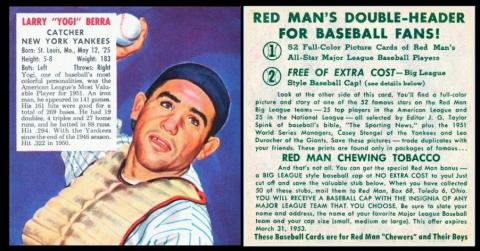
Red Man [tobacco : O/S - USA] "Major League All Stars" (1954) 20/52 - T.234
This card celebrates the birth of this man, Lorenzo Pietro Berra - yet, as he was born today in 1925, it is also a centenary card.
As you can see on the card, he was a baseball player, specifically a catcher, who caught the ball in his leather glove, or mitt. He later became a manager and then a coach, and he was most associated with the New York Yankees.
Before all that, though, he had only just signed with the Yankees, in 1943, before he was sent off to war, right into the heat of battle, including taking part in the Normandy landings as a Seaman second class, and gunner, on a landing craft, seeing service on at least two of the beaches, and maybe more, we will never really know because his military records were destroyed in a fire, along with those of many other service personnel. All we do know is that he was wounded, and awarded the Purple Heart.
That sounds life altering enough, but wait - for by the time he had been demobbed, returned home, and baseball had dusted itself off after its enforced retirement and resumed in the autumn of 1946, he was still only twenty-one years old.
He was married three years later, and had three sons, all of whom were keen and talented sportsmen. His wife died in 2014, and he died eighteen months later, in his sleep.
There are many biographies of him online, but I have picked the one at the Yogi Berra Museum and Learning Center website, which is a fascinating read, with many personal pictures - and the museum owns much of his memorabilia.
To close, it took a while to find out why he was known as "Yogi". Apparently it was given him by a friend when he was still a teen, playing in American Legion baseball, And reputedly it was because when our man sat dejectedly waiting to go out on the field, or after a less than successful game, he would sit with his arms and legs crossed, just like an Indian mystic, or master of yoga, meditating.
This card was issued with chewing tobacco, and the set was the first national issue of baseball cards by any form of tobacco company since the 1920s. However it was on rather rough card, so rough that I presumed it to be a package issue, especially as some cards I saw whilst trying to research this one had dotted lines at the base. That mystery was cleared up when I discovered that the cards originally had a section below the image. These are known as "the tabs" and cards with them are worth more. However they are hard to find, as if you sent fifty of these tabs up to Red Man, they would send you back a baseball cap, from the team of your choice. And you can tell how many baseball caps were distributed by the fact that they changed the system for the three sets which followed - these were then numbered on both the tab and on the card that was left after the tab had been removed.
The set of fifty-two cards is made up of the best twenty-five players in each league (not sure yet how these were chosen) plus two cards that show the managers of the two teams that were up for the World Series - Casey Stengel for the New York Yankees and Leo Durocher for the New York Giants. .

Willi STUNINGS [trade : motor parts : OS - Krefeld, Germany] "Das Kraftfahrzeug" / "The Motor Car" (1950) Serie C Gruppe 2 No.1213/1500?
Still with sport, today in 1950 saw the first Formula One Grand Prix, at Silverstone.
Of course there was motor racing before, and Grand Prix, way back as far as the 1920s, but what are considered as the origins of Formula One began only in 1946, when the Federation Internationale de l`Automobile rejigged the many assorted rules throughout the many variants of motor racing and made one set of official rules. This was then followed by the staging of a World Championship of Drivers, which took place in 1950, starting with our race. However it was imagined all the way through the rule wranglings that the top classification of this would be Formula A, not Formula One - that was only decided on during the early months of 1950.
Our race was to be known as The Royal Automobile Club Grand Prix d'Europe Incorporating The British Grand Prix, and it was the fifth British Grand Prix, the first being held in 1926 at Brooklands, which was also the course of choice the following year. Then it was not held until after the end of the Second World War, in 1948, at which point it relocated to Silverstone - but there had therefore been two before our race of today took place.
That race was won by Emilio Giuseppe "Nino" Farina, in an Alfa Romeo, and his two stablemates, Luigi Fagioli and Reg Parnell brought their Alfa Romeos over the line in, respectively, second and third places.
Now our card is a bit of a tangent, for it is car 42, and the photo comes from the 1946 Turin Grand Prix - but it was driven to victory in that event by our winner today, Emilio Giuseppe "Nino" Farina. And time was running out, so I grasped this and held firm.
Plus there are many people who completely discount the 1950 British Grand Prix as being the first Formula One race, saying that the rules were already pretty much firmed into cement by the time that racing resumed in 1946 with the Turin Grand Prix, and that from then on until the end of 1950 that not a single alteration was made to them.
Though all agree that the British Grand Prix of 1950 was the first to call the classification as Formula One.
As for the card, confusion reigns. "Wistu" is often quoted as the maker, maybe because it is at the top of the card, but that just means knowledge. And as far as the bottom, there was not a whiff of Willi Stunings in our World Tobacco Issues Index, which led me to suspect straight away that it was a trade issue, hence a dead end, for few books of German trade cards seem to exist. However if you translate all the wording it says that Willi Stunings was a firm that made car parts, specifically gauges and electronics. The text also tells us that this set is issued in sections, covering different ages and types of vehicles, including motorbikes. So one day there may be a checklist of those groups and what they cover.
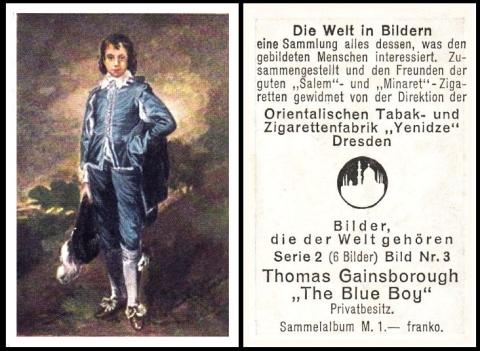
Orientalischen Tabak- und Zigarettenfabrik "YENIDZE" [tobacco : O/S - Dresden, Germany] "Die Welt in Bildern" (1930) Serie 2, Bilder 3 - Y260-800 : Y6-1 : X24/.8.J
Back into the past now, with this portrait, "The Blue Boy" by Thomas Gainsborough, who was baptised today in 1727.
We know that he was born at Sudbury in Suffolk, and that his father John was a weaver, whilst his mother, Mary, was the daughter of a local Reverend, after whom one of Thomas` brothers was christened. However the fact that his baptism is recorded, and on a Wednesday, inevitably means that his actual date of birth is not. However we do know that the practise, especially in rural areas was simply to ensure a child was baptised before the next Sunday came along. And if we look at Thomas Gainsborough`s parentage, on his mother`s side, perhaps his baptism was much closer to the birth than many.
He was very young when it was noticed that he was a talented artist, and he attempted his first self portrait aged just ten. he was thought to be worthy of improving, and so in 1740, aged just thirteen, he went to study art in London, ostensibly to be trained by Hubert Francoise Gravelot, but spending more time in the more raucous company of William Hogarth. Some say that he was also allowed to infill some of Hogarth`s works, to a greater or lesser extent.
However this way of life seems to have ended when Thomas Gainsborough met Margaret Burr, the natural daughter of the Duke of Beaufort. She seems to have settled him down, though there are suspicions that he only married her because her father was supporting her, and giving her £200 a year - a sum which equates to almost £37,500 today. It is also known that Thomas Gainsborough`s own paintings of the time were usually landscapes, and had not been selling well, though his expenses in the hunt of pleasure were pretty hefty.
He managed to convince her to move to Suffolk, two years after they were wed, and had the idea of painting portraits of local nobility, etc. By 1752 he had two daughters, and the family moved to Ipswich. The idea of painting the nobility had not worked out, and though he had commissions, they were mainly the clergy, merchants, and gentlemen farmers, not the higher end he had hoped for. His next plan was to move to a more affluent area, and he chose Bath, somehow, and we do not know how, moving into a grand house which was part of "The Circus", a very sought after address to this day. Perhaps because of this he did start getting better clients.
Shortly after this he joined the Society of Artists of Great Britain, and decided to send a painting up to their annual exhibition. Within ten years he was a founder member of the Royal Academy, and also exhibited with them. This also increased his clientele, but a few years after there was some kind of falling out, and he no longer sent them works.
In between, though, he had developed what would become his style, incorporating landscape with portraiture. It appears that this gave him the best of both worlds, he enjoyed painting the landscape, and the portrait made the money, from the person depicted.
Our portrait is unusual, as it seems that the blue boy never existed, though many art critics have attempted to connect him with people of the time, without success. It is also said to resemble another painting, a double portrait by Anthony Van Dyck, using parts of both the boys, so perhaps it was even a test piece to practise the skill of combining the two genres, landscape and portrait, and we know that it was one of the first of his works of this kind, if not the first.
We also know that it was sold to a Mr. Buttall, a merchant, whose son was long suspected to be the model, then passed through several hands until 1921, when it was bought by Henry Edward Huntington and shipped to California, where it remains to this day.
As far Gainsborough, he eventually moved to London, and did gain considerable fame in his lifetime, but died of cancer aged just sixty-one.
Our card actually fills a important gap in our knowledge and our depiction of this set and all its varieties, which are combined and discussed on a homepage which you can find with our Card of the Day for the 2nd of February, 2022.
The important bit regarding our issuer is that they only ever did this one set, and only the first part of it, just 144 cards. All the other issuers, nine of them, published more than one part of the set, to a maximum of one thousand four hundred and twenty cards (that being the total issued by Josetti, Manoli and Salem).
Our issuer appears in our original World Tobacco Issues Index as :
Orientalischen Tabak- und Zigarettenfabrik "YENIDZE", Dresden, Germany
German language issue, period 1928-1942. Special album issued.
- Die Welt Im Bildern (The World in Pictures). Sm. 58 x 40. Nd. Serie 1/24 (144). See X24/.8.J ... Y6-1
This is slightly different in our updated World Tobacco Issues Index, where the entry reads :
Orientalischen Tabak- und Zigarettenfabrik "YENIDZE", Dresden, Germany
German language issue, period 1928-1942. Associated with Salem. Special album issued.
- DIE WELT IM BILDERN (The World in Pictures). Sm. 58 x 40. Nd. Serie 1/24 (144) ... Y260-800
Now Salem were also in Dresden, and also issued this set; in fact, as we discussed earlier, they were one of three companies who circulated the entire set, of one thousand four hundred and twenty cards.
Whilst I hunt the link between Salem and Yenidze, take a look at the reverse of this card, at the building in the small circular image, and you may think this a mosque, purely designed to symbolise the "Orientalischen" of the company name. However, this is actually the silhouetted skyline of the Yenidze Cigarette Factory, and it still survives, though it was damaged during the horrendous bombing of Dresden by Allied forces, and then suffered years of neglect and emptiness. Recent and sympathetic renovations have now found it a new purpose, as offices.
The company was started by a Jewish man called Hugo Zietz, in order to import tobacco from Greece. The place that the tobacco came from, Yenidze, gave him the company name. The building was designed to support the Oriental connection, as well as to get around planning law which forbade too many factories. Construction in 1907, and it took two years to build, most of which was spent sourcing the tiles to cover it, plus making the six hundred windows, and fitting them all into place. Mr. Zietz did get to see his dream realised, though he died in 1934, by which time his factory had been absorbed into Reemstma.

C. BERIOT [trade : chicory coffee : O/S - Lille, France] "Advertising Card" (??) 1/1 ?
Now we move to a fairly new celebration, which perhaps you will find useful. That is "Bring Flowers to Someone Day", and it is designed not to ask you to go online and pay for someone to deliver such, but to think of someone to whom you can walk and physically take them some flowers.
It is also, rather wonderfully, not a romantic celebration, it is purely a declaration of friendship, no need for mixed messages, or reciprocation of any kind.
Sadly I cannot bring you my originally intended card, an advert featuring a very handsome frog with a bouquet, I struggled, but it was one of those cards where the back was too light and the staining too dark.
So what we have instead is a standard bouquet, which, I also realised, after I had started to work on it, ties in nicely with the other "A La Belle Jardiniere" card we used in our V.E. Day remembrances, the large clothing store, this "A La Belle Jardiniere" being a brand name used by C. Beriot, of Lille
The flowers used in this seem to be hellebores and snowdrops, a symbol, perhaps, of the end of winter and the coming of spring. However Hellebores are rather interesting in the language of flowers, possibly because their flowers hang upside down, so whilst they mean solitude, and peace, they can also mean lying low after scandal, until the fuss dies down. As for the snowdrops, they bring hope for new beginnings, for and long awaited change.
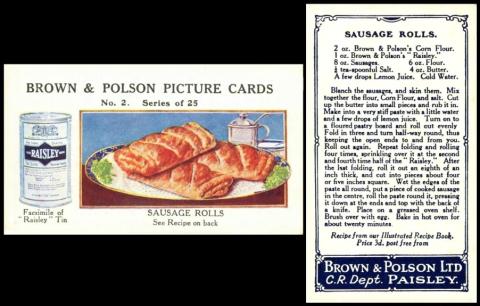
Brown and Polson [trade : baking powder : UK - Paisley, Scotland] "Picture Cards" (1925) 2/25 - BRR-1
Almost forgot this one, after the fun I had with it. I will start by saying that it marks #NationalBarbecueDay, and before anyone comments unfavourably, you can barbecue sausage rolls, and add pickle, mustard, and barbecue sauce. You can also use vegan sausage rolls, and maybe you ought to.
Anyway I failed to find a sausage, and time ran out. I could say that was because nipper got in the fridge whilst I was not looking, but he only has eyes for the cheese or the cheesecake. So if you find teeth-marks in your cheesecake, and a corner (or a bit more) missing, you know who to blame.
This card is very unusual, and it not only advertises the company products, but a booklet of recipes that could be obtained from them for just 3d. post free.
Some of the cards show pictures of the food produced by following the recipe on the reverse, whilst others show women making the food, and these have no recipe.
Eventually there will be a list, but not tonight, for I only just realised I had not even looked for an event on Friday, let alone a card...
Our original British Trade Index has a very short description, but it reveals that it was their only issue. The full text reads :
BROWN & POLSON, Ltd., Paisley, Scotland
Cards issued 1925.
- BROWN & POLSON PICTURE CARDS. Md. 88 x 51. Recipes. Nd. (25). ... BRR-1
This week's Cards of the Day...
... continued, a bit, with last week`s theme, and spoke of the eightieth anniversary of Victory in Europe, or V.E. Day, a running remembrance through the week, with lots of ceremonies and tributes going on in this country and across Europe.
You may be wondering why eightieth? Well if you think about it, the youngest participants, say sixteen, if they lied about their age, plus eighty, are now ninety six. Few of those will live to see the hundredth anniversary, let alone the people who were in their twenties or thirties; so this was really a way of paying tribute whilst the participants could still be there.
I found it quite hard to find cards of the Second World War to feature, cards ceased for the duration of the war and did not get going until some time afterwards. In addition, the war was still too sad to want to stir it up again. One of the few sets that did arrive fairly early was Joseph Lingford & Son`s "British War Leaders", issued in 1950 with baking powder, cornflour, jellies, and pudding mixtures. I am sure we have used this card somewhere and when I find it I will link it in here.
And so to the cards of this week - which started with
Saturday, 3rd May 2025
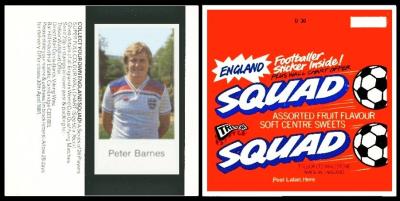
This was chosen simply because it was issued in 1980, and this year is the eightieth anniversary of V.E. Day. A bit of a tenuous link, but I failed to find a card number eighty from a set I had not used before.
Our star player today is Peter Simon Barnes, who was born in June 1957. His career has included playing, managing, and commentating on football, and he is also probably remembered by some of our readers as the son of the 1950s Manchester City player Ken Barnes.
This item is slightly borderline in some people`s definition of "cartophilic", but you can find the footballer portrait without the wax wrapper, either peeled off, as intended, and then stuck on to something else, or cut round leaving a part of the wrapper on the back.
At which point I ought to say that I have shown both images the right way up for easy reading, whereas on the original the wrapper would have been turned to the left, so that the "card" is stuck behind the "SQUAD" word which appears at the top on our picture. In fact, you would be lucky indeed to find the wrapper and card in this easy to read a condition, for it was not issued round cards like usual bubblegum wrappers were, instead it was rolled around a silver foil paper that contained sweets rather like fruit gums, but harder, with an outer shell coating and an inner that was soft and chewy - and each packet included a mixture of assorted flavours, either blackcurrant, lime, or strawberry (none of which would have appealed to me)
A complete set was twenty-six footballers, and they were to be stuck on a special wall chart. This may amaze our younger readers, but the wall chart was free, you only had to send in a coupon with your name and address, and some stamps to pay for the post and packing, which was the grand sum of 20p....
Mind you that was just four pence more than three rolls of the sweets, which retailed for 8p a roll.
Trebor Ltd. first appear in our original British Trade Index part two, and though this set is not there it shows they had form as to the style of this set, for they are described as "Bubble Gum. Wax-paper issue". However this book only covers sets from 1955 to 1965, and ours is later, late enough to be included in our next part of the British Trade Indexes, namely part three, that covers issues up to 1986, it is not there either - though section 1 of the Trebor listing does state it is for "Wax-Paper issues", though only those in the 1950s and 1960s.
I will see if I can find them as a New Issue in our magazine by the time the newsletter comes out!
After this, at the end of the 1980s, Trebor was bought out by Cadbury-Schweppes. And in 1990 it was renamed to Trebor-Bassett.
Sunday, 4th May 2025
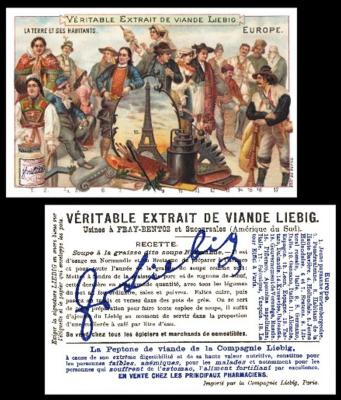
This card shows the people of Europe, as they were in 1890. And as such, it includes many nations who were caught up in both World Wars, on both sides. Sadly even after the victory, many of these peoples would have lost members of their families, and their homes, and sometimes seen their countries and customs also lost, as the borders changed and the reparations started.
The cards in this set are :
- Afrique [Africa - The Sphinx]
- Amerique de Nord [North America - The Capitol at Washington]
- Amerique du Sud [South America - Palace of Justice at Santa Fe]
- Asie [Asia - Koung Fu Pagoda at Shanghai]
- Europe [Europe - Eiffel Tower]
- Oceanie [Australasia - The new Town Hall at Sydney]
Each one numbers the peoples and there is a key on the reverse. There is also a large section on each front with a notable building, and this is also identified on the reverse list, but they are not always the last one on the list, I now know.
I also know that the new Sydney Town Hall was officially opened on November 27, 1889, so that ties in very nicely with the date that is usually linked to this set of 1890.
Monday, 5th May 2025
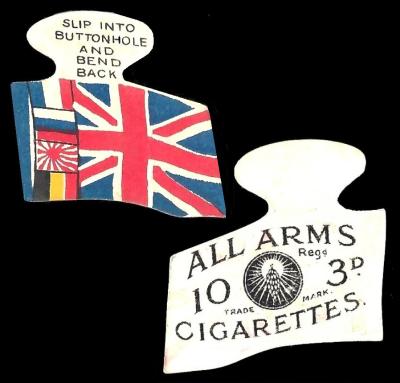
This may be a First World War set, but it is included because at the end of the Second World War, flags flew in multitudes, and, at the moment, for the eightieth anniversary of V.E. Day, lots of houses are displaying flags, and other decorations. I love to see them as I pass on the bus, but I do wonder why that one house is so keen, did they, perhaps, have a relative who fought, young, and is maybe still alive? Or did their ancestor(s) go to war and not return, and they are determined that as long as a relative survives they will never be forgotten?
If your house is decorated, do, please, reveal why....
This card turns out to reveal a really intriguing story. It was sent to me as a scan, named as "Carreras", and when I started at the beginning, as I always do, I found it recorded in the 1950 London Cigarette Card Company catalogue for British Cigarette Card Issues between 1888 and 1919, under Carreras, as :
- 1. Col. 6 Flags of the Allies (shaped) H.49.
odds sets
1 Grouped Flags
A. "All Arms" Cigarettes ............ - 20/-
B. "Black Cat" Cigarettes .......... - 40/-
5 Allies Flags ................................... 10/- to 30/- -
H.49 takes us to the original pair of handbooks, published, uniform with that volume, in 1950, where it is listed as :
- H.49 FLAGS OF THE ALLIES - Shaped (adopted title). Shaped for buttonhole. Fronts per. Fig.49 in colour. Issued by Carreras. Unnumbered.
Grouped Flag - Union Jack and four Allies flags as illustrated in Fig. 49-A. Two backs :
A. "All Arms" Cigarettes
B. "Black Cat" Cigarettes
Allies` Flags - One illustrated in Fig, 49-B. All with "Black Cat" Cigarettes back. Series of 5 :
1. Belgium (black, yellow and red)
2. France (Red, white and blue - vertical)
3. Japan (red and white sun)
4. Russia (red, white and blue - horizontal)
5. Union Jack
Now in 1956, a second pair of books were issued, the catalogue and handbook for British Cigarette Card Issues 1920-1940, though they also updated the earlier pair. So in the catalogue, we read :
Carreras Ltd.
Pre-1919 issues.
See additional information under Ha.49 and amend Set.1 to the following
- 1. Col. 6 * Flags of the Allies (shaped) ... Ha.49
1. Grouped Flags :-
A. "All Arms" Cigarettes
B. "Black Cat" Cigarettes
2. Allies Flags (5) :-
A. "Black Cat" Cigarettes
B. "Life Ray" Cigarettes
Whilst in the handbook, this is updated to read :
- Ha.49. FLAGS OF THE ALLIES - Shaped. It should be noted that Carreras` name does not appear on the cards. Two printings are known of the "Allied Flags" -
A. "Black Cat" Cigarettes
B. "Life Ray" Cigarettes
Their next appearance is in our World Tobacco Issues Index, under Carreras section 1.B, for "Miscellaneous Issues", as
- FLAGS OF THE ALLIES (A) Small, shaped. Unnd. Without captions ... C18-8
1. Series with button-hole attachment. See H.49 and Ha. 49. Series of 6 - Grouped flags on Union Jack and five Allies Flags. Brand issues, inscribed
(a) "All Arms"
(b) "Black Cat"
(c) "Life Ray" Cigarettes
2. Series with pin as flagstaff. Inscribed with Black Cat trade mark and initials "J.C.C."
One seen (French flag)
And by the time of our updated version, this has been reduced, to
- FLAGS OF THE ALLIES (A) Small, shaped. Unnd. Without captions. See H.49 ... C151-090
A. Series with button-hole attachment
B. Series with pin as flagstaff. Inscribed with Black Cat trade mark and initials "J.C.C."

However, then I discovered something totally amazing, and that is that the card we show above was not actually issued by Carreras at all.
It turns out that they only issued one version, the one with the "Black Cat" Cigarettes trademark, on the back, which is showing here as a quick comparison.
The front of our card, above, may be exactly the same as the Carreras one, but it turns out, after a lot of research, to have been issued by another firm entirely. They were called Ray & Co. Ltd, and they are actually listed in our "Directory of British Issuers" (RB.7, first published in 1946) as :
- RAY & Co. Ltd.
238/240, City Road, London, E.C.
Name carried on by Carreras Limited (see entry under that name)
Cigarette cards issued during war 1914/18 with "Life Ray" and "All Arms" Cigarettes
No issues since.
I therefore replaced my steps, to find that in the 1950 London Cigarette Card Company catalogue for British Cigarette Card Issues between 1888 and 1919, there is a listing for Ray & Co, but only for this set :
- Ray & Co. Ltd, London
odds sets
1. BW 25 War Series - 1-25 - Battleships 25/- to 75/- -
2. Col. 75 War Series - 26-100 - British & Foreign Uniforms 8/6 to 25/- -
3. Col. 25 War Series - 101-125 - British & Dominion Unforms 15/6 to 45/-
Note that there is no Handbook code for this set, at this time. That only comes in the follow up catalogue, for issues 1920-1940, where the entry reads :
- Ray & Co. Ltd., London
Pre-1919 issues
See additional information under Ha.472
Though Ha.472 is only for the "War Series", it does include something very interesting, regarding another issuer, and that is :
- Ha.472. WAR SERIES (titled series). Numbered series of 125, issued in three sections. Nos. 1-25 (Battleships - black and white), Nos. 26-100 (British and Foreign Uniforms - coloured), Nos. 101-125 (British and Dominion uniforms - coloured).
Ray & Co., London - Pre-1919 tobacco issue.
Carreras & Marcianus, Montreal. Overseas tobacco issue Burdick C.250
Now Carreras & Marcianus was a firm of two halves :
"Carreras & Marcianus Cigarettes, Ltd, London" was actually started by Carreras, in 1904, as an "allied company". It was based at St. James` Place, in Aldgate, E.C.3, in premises that Carreras already owned, and its purpose was to trial, and then to produce cigarettes by machine. These were then retailed under the name of `Black Cat` Cigarettes. However we do know of an issue under the Carreras & Marcianus Cigarettes, Ltd, London name, a set of small folders, each of two coloured miniatures.
Then there was "Carreras & Marcianus Cigarettes of Canada, Ltd.", and, guess what, they issued the same "War Series" as Ray & Co.
The important thing about both of these Carreras and Marcianus-es is that they are listed in our original World Tobacco Issues Index as being an "Associate of Carreras". And in that same book, the entry for Ray & Co. Ltd, reads :
RAY & Co. Ltd, London
Associated with Carreras, Ltd. Cards issued about 1915
- WAR SERIES. Sm .67 x 36. See Ha.472 ... R-6-1
1. Nd. 1/ 25. (25) Battleships. Black and white
2. Nd. 26/100. (75) British & Foreign Uniforms. Coloured
3. Nd. 101-125. (25) British & Dominion Uniforms. Coloured.
It is not until the updated version of the World Tobacco Issues index that our set is allied to Ray & Co, with an entry that reads :
RAY & Co. Ltd., London
Associated with Carreras, Ltd. Cards issued about 1915. Includes brand issues inscribed "All Arms" and "Life Ray".
- FLAGS OF THE ALLIES (A) Min,, shaped for buttonhole. Brand issue. Unnd. ... R097-300
1. Grouped Flags, inscribed "All Arms" Cigarettes (1)
2. Individual Flags, inscribed "Life Ray" Cigarettes (5)
- WAR SERIES. Sm .67 x 36. See Ha.472 ... R097-800
1. Nd. 1/ 25. (25) Battleships. Black and white
2. Nd. 26/100. (75) British & Foreign Uniforms. Coloured
3. Nd. 101-125. (25) British & Dominion Uniforms. Coloured.
The section relating to our set does not mention an "H" code for the modern handbook, but there is one, still numbered H.49, which you may remember was cited with the Carreras entry, just not the Ray one - and that reads ;
- H.49. FLAGS OF THE ALLIES - Shaped (adopted title). Shaped for buttonhole. fronts per Fig. 49 in colour. Issuer`s name does not appear on the cards, Unnumbered.
I - Grouped Flag - Union Jack and four Allies` flags as illustrated in Fig.49-A
Carreras - "Black Cat" Cigarettes.
Ray - "All Arms" Cigarettes.
II - Allies` Flags - One illustrated in Fig. 59-B. Series of 5
Carreras - "Black Cat" Cigarettes.
Ray - "Life Ray" Cigarettes.
1. Belgium (black, yellow and red)
2. France (Red, white and blue - vertical)
3. Japan (red and white sun)
4. Russia (red, white and blue - horizontal)
5. Union Jack
To close, the very nature of this item, where the instructions tell you to bend the white, shaped, section down to fit in your buttonhole, would have led to its damage and eventual discarding - and to their rarity today.
And it seems an opportune moment to reveal that there was another "buttonhole" set of "Flags of the Allies", but using a different system where the entire item went straight down the buttonhole and left the top with the flags to stand out. These were issued by W.D. & H.O. Wills - and you can read about those elsewhere on this website, for they were ourCard of the Day for the 7th of May, 2024
Tuesday, 6th May 2025

We have Winston Churchill today not for the fact that he was Prime Minister during the Second World War, but because it was his voice that came on the radio at 3 pm in the afternoon of the 8th of May 1945, and announced that the Germans had surrendered.
And this is therefore considered to be the date of the Victory in Europe.
That was not the end of the war in other places, and it was not really the end of the war in Europe, many troops lost their lives after the supposed victory, from snipers, land mines, and from ill feeling between the oppressors, once captured, and the oppressed, once freed.
This is a card that was issued in Germany, in German. The top box starts with the words "Von Nurnberg bis Stalingrad", or "From Nuremberg to Stalingrad", and it is often sold under this title. However, this is not the name of the set, that is "Der Zweite Weltkrieg im Bild", or The Second World War in Pictures", and it is a set of sixty series, each of six picture cards. Our card is from Serie 13, and it is the final picture in the group, picture 6.
The main text title says "Angriff auf London und Coventry - Militarischer Fehlschlag" - that means "Attack on London and Coventry - Military Failure". I will try and translate the whole as it could be quite interesting. Below this in the box it tells us that the set is split into two parts, Band 1 for series 1-30 and Band II for series 31-60,
The bottom section is "Viele Rauchen" means "many smoke", Eilebrecht is the company name, and "erzeugnisse" actually means products.
The set is first listed in our original World Tobacco Issues Index, which was published but four years after the set. There are two sets listed, each of two series, and the entry reads :
EILEBRECHT Cigaretten und Rauchtabak-Fabriken A.-G,
Baden-Baden, GermanyGerman language issues, 1950-52. Special albums issued.
- KARL MAY SERIENBILDER (Karl May Series). Lg. 103 x 70. 50 sub-series, each Nd. 1/6 ... E19-1
1. Band I. Serie 1/20 (120)
2. Band 2. Serie 21/50 (180)
- DER ZWEITE WELTKRIEG IM BILD (The Second World War in Pictures). Lg. 104 x 70. Grey-black. 60 sub-series, each Nd. 1/6 ... E19-2
1. Band I. Serie 1/30 (180)
2. Band 2. Serie 31/60 (180)
I will try to use the Karl May series some time, for he is an intriguing character, best known for his stirring world-wide adventure novels, several of which feature a cowboy character (said to be based on himself) called Old Shatterhand.
Now in our updated volume of the World Tobacco Issues Index there are three groups of sets, the two above, for which the text had not changed, only the codes - plus "MUNCHHAUSEN`S ABENTEUR (Adventure of Baron Munchhausen). Lg. 105 x 70. 15 groups, each numbered 1/6 (90). Special album to hold 30 series (180 cards) half of which is for a set of Don Quixote which has not been studied ... E-380-500"
So if there are any German readers, who have that set, do please tell us.
Wednesday, 7th May 2025

This card was selected because it shows a group of children, dressed as sailors, celebrating, and though the forces would have celebrated greatly, they would have also felt their losses the strongest, and there would have been much remembrance of colleagues that were no more.
The name "Maison a la Belle Jardiniere" actually translates to house of the beautiful garden. This may seem to have no connection with clothing, but for some reason it was chosen as early as 1824, when Pierre Parissot opened a shop selling ready to wear clothes, rather than ones you had to be fitted for and wait for them to be sewn. And his sign showed a gardener, watering flowers.
Now there is actually another "A la Belle Jardiniere", that is a brand of chicory coffee, by C, Beriot, also of France, but based in Lille, not Paris. This is the easiest way to tell which is which, though another way is to look and see if there are "succursales" with a list of other addresses - for these are branches, or offices, and that only applied to the clothing store, not the coffee.
Thursday, 8th May 2025
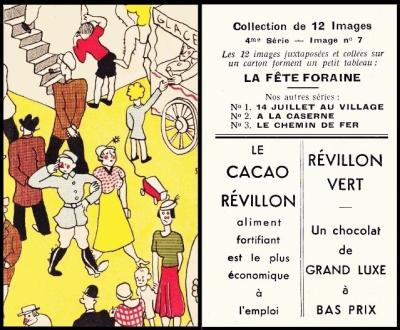
This card was selected simply because it was a celebration, and there is a soldier, right in the middle.
It is an interesting issue, and became more, the more I delved. There is also a link to the Second World War which I did not realise when I got the card.
For a start we have the artist`s name on one of the cards, and that is quoted as "Bernard Aldebert", but his full name was Jean Bernard-Aldebert, and he was a very prolific cartoonist, satirist, and illustrator, whose works are very collectable today. I wonder if those collectors know he drew these cards, too? However in his lifetime his cartoons attracted notoriety too, and during the Second World War one of them caused him to be arrested and sent to a concentration camp, which, somehow, he survived. Not only that, but he wrote an illustrated book about his experiences.
After the camp was liberated, he returned to France, and stayed away from the more satirical works, though he did still work as an illustrator. In fact he was also one of the many illustrators who drew for the Tintin books, it being far too much work for Herge to do alone.
I am not sure when he did these cards, I have seen them offered for sale with several dates between 1925 and 1938. The 1925, I think, is too early; he only started to make a name for himself in 1928, when he was signed up by the popular magazine Le Pele Mele. You could say that he did these first, but his name is on them, and this generally only happens after you are famous. The people drawn are quite rounded, which suggests the 1930s, in the 1920s they would have been drawn slimmer, fashions change in all things.
The grey uniform of the soldier is also not much help, if he is French then that puts the cards as being between 1903 and 1914, which is when a succession of new colour schemes were trialled, but this is too early for our man, he was only born in 1909. As for the Germans, they first tried a grey uniform in 1910 (which may have been the reason the French abandoned theirs) - but they kept it, right until the end of the Second World War. As far as East Germany, they retained their grey uniforms right until the 3rd of October 1990, when they joined West Germany, to become one country, the Federal Republic of Germany.
Now the idea behind the issue is that this card is put next to the others and it makes a large sectional picture. There are other series of these cards, that also follow the same pattern, for on the back of ours it lists three, and that presumably makes ours series four. Their names are :
- 14 Juilliet au Village (14th of July in the Village - Bastille Day)
- A La Caserne (At the Barracks)
- Le Chemin de Fer (The Railway)
- Fete Foraine (Travelling Fair)
Our man definitely did the artwork for series 2, 3, and 4, but I have not found series one yet. And only one card in each series has his signature.
Friday, 9th May 2025

This was included because bells were a huge symbol of V.E. Day, and our church also rang them this year.
There is also another connection, which our younger readers may not know, and that is that during the Second World War, starting in 1940, ringing bells was actually banned. The reason for this was that bells were only to be rung in the event of a German invasion. There is another layer to this, as it was believed that the Germans would not realise that we had stopped ringing the bells and would also not realise that it was a symbol for the civilians to flee and the forces, or any person who wished to remain and fight, to stand and take up their arms. This ban remained for three years, and it was only lifted in order to celebrate the Allied victory at El Alamein. It was then allowed that they be rung to celebrate the following Christmas, and in June 1943 it was decided that the threat of enemy invasion was unlikely, and so the bells were allowed to be rung.
However, there was difficulty with this, as most of the men who had formerly rung the bells were either away on War service or had been already killed. And at that time there was a certain resistance to allowing women to ring them, though eventually this was allowed, and it helped to restore some of the numbers.
This card is quite a scarce one, and it is really lovely, full of humour and charm.
Each bell has a name and is being rung, rather lustily, by characters related to that bell`s purpose. In our case the bell is a "tocsin" or alarm bell, and so it is being ridden by two firemen in their golden brass helmets and full uniform. The full set comprises :
- La Cloche d`Alarme - alarm bell - two sailors above a stormy sea
- La Cloche de L`Ecole - school bell - two school boys
- La Cloche de l`Hotel - hotel bell - a chef and a housemaid
- La Cloche du Bapteme - baptismal bell - an elf and someone in a christening gown
- La Cloche du Chateau - house bell - a pair of uniformed servants
- Le Tocsin - the alarm bell - firemen
The unusual one is La Cloche du Bapteme, because this is a naval phrase, relating to that fact that if there was a birth at sea the infant would be baptised under the ship`s bell. ban was lifted (which many people do not remember)
And now I must depart, for slumber. Ran a bit late this week.
